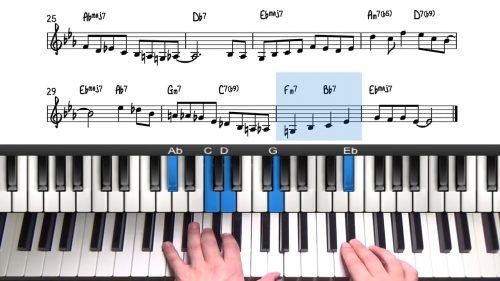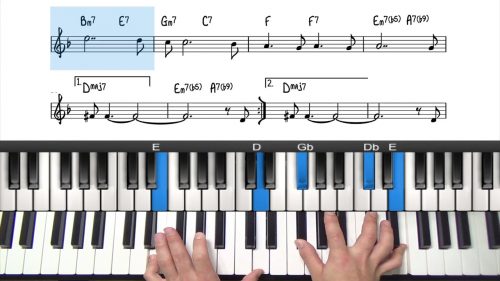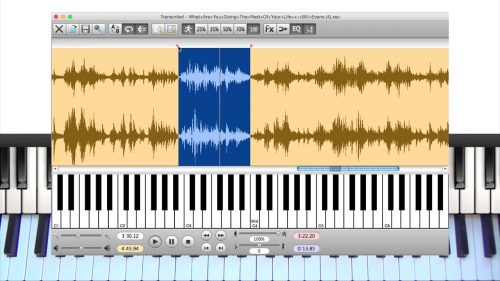How To Play Swing Rhythm
If your musical experience has been mostly classical piano study, you will likely find when you try to play jazz, it doesn’t sound the same as the jazz musicians you hear on records.
This is because classical music is played and felt with a straight feel and jazz music is most often played with swing feel.
To quote Duke Ellington who was one of finest jazz pianists to ever live, “It don’t mean a thing if it ain’t got that swing“.
In this lesson we are going to cover all of the information you’ll need to learn how to swing. We’ll start off by identifying and demonstrating the differences between a swing feel and a straight feel.
We will then break down the anatomy of swing and discuss how this is notated and interpreted in the context of jazz standards, lead sheets and transcriptions.
Finally we will talk about the variables, dynamics and intricacies of swing and how you can apply these to your playing today.
What Is The Difference Between A Straight Feel & A Swing Feel?
I will start of the lesson by demonstrating the difference between a straight and a swing feel. We will do this in the context of a scale and then in the context of a line over a 251 in C Major.
Why Is Swing Rhythm Not Notated?
If we take a line of 8th notes but notate it with actual swing rhythm, you can see that it looks overly complicated and much more difficult to read. For this reason, jazz musicians understand that swing rhythm is implied for 8^th^ notes.
How to Add Accents To Swing Lines
A very important point is the accents. The final triplet of each beat should be emphasized. By doing this you are emphasizing the up beat which is the & of each beat. But remember in swing rhythm, the & falls somewhere around the 3^rd^ triplet of each beat
One thing you may find tricky is not accenting the beat when the chord changes. The chords change on beats 1 and 3 and in classical music, these beats are accented and so it may take some practice and reconditioning to get out of that habit.
Swing Rhythm – Where To Start The Phrase
So you have 2 choices available to you here, the down beat, or the up beat. Remember that the upbeats are emphasized in swing rhythm and so if you come in on the upbeat, you should be accenting the first note.
Remember you can come in on any of the upbeats, he we come in on the first up beat but you could also start your line on the upbeat of 2, 3 or 4.
Lesson Downloads
-
Swing Feel Lesson Supplement File Type: pdf
Practice Tips
-
I would highly recommend that you record yourself practicing swing so that you can listen to it subjectively. It's difficult to do this whilst playing or performing.
-
I've had a few students express their interest participating in jazz jam nights and if you're thinking of doing this you will indefinitely need to work on your swing feel or your improvisations will sound flat.
-
You should also be aware that playing all of the so called 'wrong notes' with the right feel will sound better than playing the right notes with the wrong feel. Remember jazz is rhythmic music.






Im getting some epiphany vibes from here…This swing rhythmic pattern could be relatable to brazilian grooves like samba and bossa nova? They olso have an upbeat and a downbeat (in the case of samba played by the zurdo)..Só you could call it groove or swing or whatever but they all share the same black/afro origins who evolved in different parts of the world!If i m right that would be amazing!!.
Hey Ivan,
Nice question!
The feel is very different between jazz music and Brazilian music.
With the exception of jazz ballads which are often played with a straight feel, (most of the lessons I teach are jazz ballads) – any faster tempo jazz is usually played with a swing feel.
The swing feel is based on the triplet, each beat in the bar is divided by 3, to get 8th note triplets. Then if you leave out the middle triplet, you have the most basic example of a swing rhythm. There are many other nuances to swing that are hard to describe. The only way that you can truly learn how to swing is by listening to swingin’ jazz players.
A few examples:
– Wynton Kelly
– Oscar Peterson
– Bud Powell
– Red Garland
Everyone swings in their own unique way. My main recommendation is to listen to some of the players mentioned above – listen every possible time in the day – just from listening you will gain an appreciation of swing.
The next step is to play along with the records, transcribe their lines, and then you will be swinging yourself.
Then onto Brazilian grooves… Brazilian music is most often played with a straight feel. Jovino explains that in his lesson on Bossa Nova improvisation: https://www.pianogroove.com/bossa-nova-lessons/bossa-nova-improvisation/ – this is very different to swing. You must understand that Ivan…. pay attention to Jovino’s demonstrations and it should all make sense for you.
Finally, yes the slave trade brought the Afro/Caribbean rhythms and grooves to the USA. This then mixed with tonal harmony that you would associate with Western Classical Music, and this formed the origins of blues and jazz music.
Jovino talks about the specific history, origin, and influences of Brazilian music towards the end of his lesson here: https://www.pianogroove.com/bossa-nova-lessons/history-of-brazilian-music/
Check it out for more info.
Cheers,
Hayden
Thks for this info i definetly will be going down that road to get that jazz swing myself.But i was talking more about the rhythmical aspect about jazz and bossa..You said that jazz is primaly rhytmical so …The triplet that makes something sound jazzy reminds me of the samba rhythm played by the surdo or the bass line played in bossa nova who olso has this triplet vibe of two notes linked together and the last one alone..its a bit hard explaining it on a text só i hope the Idea can be intérpreted Just by reading it.Or i m Just tripping about something that makes no sense lol.Feel free to not answering to this message if there is nothing important to add
Hi Hayden Your indication regarding the accent on the upbeat is a shock to me, who used to tap the tempo with my foot and automatically accentuates the downbeat. It will be tough to get rid of this bad habit! But is it always true? I can hardly feel this in some of the examples of improvisations I’m studying (for example the Freddie Freeloader by Wynton Kelly)…